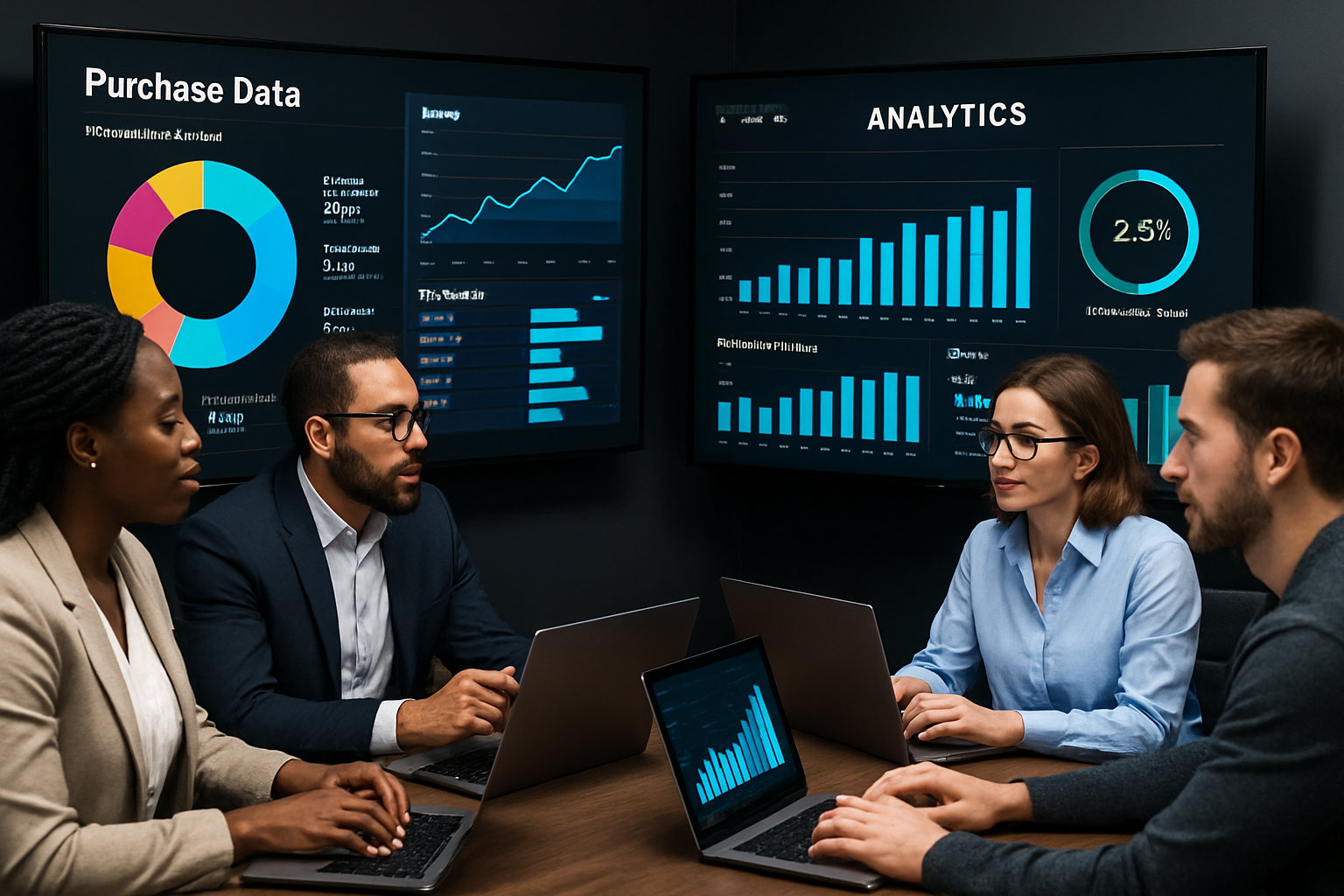In 2025, data-driven decision-making drives business growth and keeps companies ahead in a fiercely competitive landscape.
This guide demystifies purchase data, providing a clear roadmap to buy and harness its power for your organization.
You'll discover how to confidently source, evaluate, and utilize purchase data for real results.
Learn why purchase data is transforming industries, what types and sources are available, and actionable strategies to unlock value and boost ROI.
Understanding Purchase Data: What It Is and Why It Matters in 2025
In 2025, purchase data stands at the heart of every forward-thinking business strategy. But what exactly is it, and why does it hold such power for brands navigating today’s digital economy? Let’s break down the essentials, uncover its rising value, and explore the trends shaping its future.

Definition and Types of Purchase Data
Purchase data refers to the information captured whenever a transaction occurs. This includes both transactional data (such as items bought, time, amount, and payment method) and behavioral data (like browsing habits leading up to a purchase).
There are several ways businesses collect purchase data:
- First-party purchase data: Data you collect directly from customers through your own channels (e.g., your website, app, or store).
- Second-party purchase data: Data shared by trusted partners, typically in exclusive collaborations.
- Third-party purchase data: Data aggregated from multiple external sources, often sold by data vendors.
Sources can be online (e-commerce transactions, digital receipts) or offline (POS systems, in-store purchases, loyalty programs). For example, a retailer might analyze both in-store point-of-sale and online checkout data to get a holistic view.
Both B2B and B2C companies rely on purchase data. B2B firms use it for account-based marketing and product planning, while B2C brands leverage it for customer segmentation and campaign targeting.
The Strategic Value of Purchase Data
The true power of purchase data lies in how it fuels smarter business decisions. With accurate purchase data, companies can personalize marketing, segment audiences, and target the right customers at the right moment.
Consider this: brands using purchase data-driven strategies report up to a 30% increase in ROI, according to recent industry studies. For instance, many retailers have boosted conversion rates simply by analyzing what customers buy together and tailoring promotions accordingly.
Purchase data doesn’t just drive marketing—it impacts inventory planning, pricing, and even product development. By understanding which products sell best and in what combinations, companies can optimize stock and introduce new offerings with confidence.
For a deeper dive into how purchase data and sales insights shape marketing strategies, check out Understanding the role of sales data.
In omnichannel environments, purchase data unifies customer journeys across digital and physical touchpoints, creating seamless, personalized experiences.
Key Trends Shaping Purchase Data in 2025
Several trends are transforming the way organizations collect, analyze, and use purchase data.
- AI and automation: Artificial intelligence is making it easier to gather and interpret massive datasets, uncovering patterns that humans might miss.
- Privacy-first practices: With updated GDPR and CCPA regulations, companies must prioritize consent and data protection.
- Rise of zero- and first-party data: As third-party cookies fade, businesses focus more on data collected directly from customers.
- Cookieless advertising: Marketers are adopting new targeting strategies that rely less on traditional tracking.
- Growth of data marketplaces and clean rooms: Secure platforms now enable compliant data sharing and advanced analytics.
Staying ahead of these trends helps businesses harness purchase data responsibly and effectively, ensuring they remain competitive in an evolving landscape.
Where to Buy Purchase Data: Sources, Vendors, and Marketplaces
Navigating where to buy purchase data in 2025 is more complex—and more rewarding—than ever before. With new sources, platforms, and regulations, understanding your options is crucial for making smart, compliant purchases that fuel growth.

Types of Purchase Data Providers
When sourcing purchase data, you’ll encounter several provider categories.
- Data aggregators collect information from many sources, offering broad datasets ideal for trend analysis.
- Direct sources (retailers, financial institutions) supply data straight from the point of transaction, ensuring authenticity and recency.
- Specialized vendors cater to unique verticals—think automotive, finance, or fashion—delivering highly tailored purchase data.
- Global providers offer international coverage, while regional sources focus on local markets for more granular insights.
Choosing the right provider depends on your business goals and the level of detail you need. For B2B, direct or specialized vendors might be best. For B2C, aggregators often provide the scale required.
Working with the right providers ensures your purchase data meets both your operational and compliance requirements.
Evaluating Data Marketplaces
Data marketplaces have surged in popularity, reshaping how organizations buy purchase data. Leading platforms like Experian and Google offer vast inventories with varying levels of detail and freshness.
When evaluating marketplaces, prioritize:
- Transparency: Clear data origins and update cycles.
- Compliance: Adherence to regulations like GDPR and CCPA.
- Freshness: Up-to-date, relevant datasets.
- Granularity: Ability to drill down by region, segment, or SKU.
Offerings range from subscription models to pay-per-use and custom packages. Compare providers by reviewing sample datasets, pricing, and support services.
The global data broker industry is expanding rapidly, with data broker market growth projections highlighting increased investment and innovation in these marketplaces. This growth means more options and competition, but also the need for careful evaluation.
Carefully assessing marketplaces ensures you secure high-quality purchase data that matches your needs and budget.
Direct Partnerships and Data Collaboration
For exclusive insights, many businesses opt for direct partnerships. These arrangements allow for the sharing of purchase data between trusted parties, sometimes within secure “clean rooms” that safeguard privacy.
Benefits include:
- Access to unique, high-value data not available elsewhere.
- Co-innovation opportunities with partners in your ecosystem.
- Greater control over data quality and usage terms.
However, these collaborations require robust agreements and technical safeguards. Pitfalls include potential data leakage and regulatory risks if not managed properly.
A popular case involves retailers sharing anonymized purchase data to identify cross-industry trends, boosting both partners’ marketing effectiveness.
Building direct relationships can unlock powerful purchase data while deepening strategic alliances.
Legal and Ethical Considerations
With purchase data, compliance and ethics are non-negotiable. Regulations like GDPR and CCPA require strict adherence to consent, anonymization, and data minimization.
Best practices include:
- Ensuring explicit consent is obtained for all personal data.
- Using anonymized or aggregated datasets to protect identity.
- Regular audits to confirm ongoing compliance.
- Documenting all data flows and processing activities.
Third-party data carries added risk, so always vet providers for transparency and legal standing.
Responsible acquisition and use of purchase data builds long-term trust and protects your brand from legal exposure.
Step-by-Step: How to Buy Purchase Data in 2025
In 2025, buying purchase data is a strategic process that requires careful planning and execution. With the right approach, businesses can unlock valuable insights, drive growth, and maintain a competitive edge. Here’s your step-by-step guide to sourcing, evaluating, and acquiring purchase data effectively in today’s digital marketplace.

Step 1: Define Your Data Needs and Objectives
Start by clarifying why you need purchase data and what you hope to achieve. Is your goal to improve marketing segmentation, optimize inventory, or personalize offers?
Outline your business objectives, target audiences, and desired regions or product categories. Setting clear KPIs ensures you measure the impact of your purchase data investments.
Ask questions like: What specific insights do you need? How will the data be used within your existing systems? Aligning your purchase data strategy with business goals is the foundation for successful acquisition.
Step 2: Research and Shortlist Data Providers
Once you know your objectives, research potential sources for purchase data. Consider a mix of data aggregators, direct vendors, and industry-specific providers.
Check vendor reputations, client testimonials, and case studies. Request sample datasets to evaluate coverage and structure. Compare how often purchase data is updated and whether providers support your industry or region.
Evaluate integration options, pricing models, and customer support. Creating a shortlist of reliable vendors streamlines your decision-making and ensures you focus on quality sources.
Step 3: Assess Data Quality and Relevance
Quality is critical when investing in purchase data. Scrutinize sample datasets for accuracy, completeness, and recency.
Look for detailed metadata and transparent documentation. Use validation techniques, such as cross-checking sample records against your own data or industry benchmarks.
Red flags include outdated information, missing fields, or inconsistent formatting. Reliable purchase data should be timely, relevant, and ready to integrate into your analytics pipeline.
Step 4: Negotiate Terms and Finalize Purchase
Before making a purchase, review licensing agreements carefully. Understand usage rights, data sharing restrictions, and any limits on redistribution.
Negotiate for the best pricing model—subscription, pay-per-use, or custom packages—and clarify contract length. Ensure the purchase data is delivered in a format compatible with your systems (CSV, API, etc.).
Establish a process for regular updates and ongoing support. A clear agreement protects your business and maximizes the value of your purchase data investment.
Step 5: Ensure Compliance and Security
Protecting customer data and maintaining compliance is non-negotiable. Stay up to date with privacy laws like GDPR and CCPA, and ensure your vendors follow best practices.
Conduct privacy impact assessments and require proof of anonymization or consent for any purchase data you acquire. Train staff on ethical data handling and document all compliance steps.
For more on how consumer concerns are shaping data privacy, see Consumer concerns over data privacy. Taking these precautions builds trust and helps you avoid costly legal pitfalls.
Integrating and Using Purchase Data for Business Growth
Unlocking the full potential of purchase data goes beyond simply acquiring it. To drive business growth in 2025, companies must master integration, activation, and measurement. Let’s break down how to turn raw purchase data into actionable insights and real ROI.

Data Integration Best Practices
Integrating purchase data into your core marketing and analytics stack is the foundation for actionable intelligence. Start by importing purchase data into systems like your CRM, CDP, or analytics platform. This centralizes insights and ensures every team member has access to the same, up-to-date information.
Next, prioritize data cleaning and normalization. Raw purchase data often comes in different formats from e-commerce, POS, or loyalty programs. Use automated tools to standardize fields, remove duplicates, and resolve discrepancies. Normalized purchase data enables reliable analysis and supports downstream applications.
Common integration challenges include mismatched schemas and inconsistent customer identifiers. Solve these issues by mapping data fields carefully and leveraging middleware or ETL solutions. For example, a retailer integrating online and offline purchase data improved campaign targeting accuracy by 25% after resolving schema mismatches.
Integration Checklist:
- Import purchase data into a centralized system
- Clean and normalize all records
- Map customer IDs across sources
- Use ETL tools for automation
- Test with sample datasets before full rollout
A well-integrated purchase data pipeline powers faster decision-making and seamless campaign activation.
Activation: Turning Data into Insights and Action
Once your purchase data is integrated, the real value emerges through activation. Segmentation is the first step—group customers by buying patterns, frequency, or product preferences. This allows for tailored messaging and more precise targeting.
Personalization becomes possible when you use purchase data to recommend products based on past behavior. Real-time processing enables dynamic offers and triggers, such as sending a discount code after a high-value purchase. Batch processing is suitable for scheduled campaigns, while real-time data drives immediate engagement.
For deeper insights, advanced analysis like market basket analysis uncovers product pairings and cross-sell opportunities. Want to go further? Discover advanced market basket analysis strategies to extract actionable insights from your purchase data and supercharge your campaigns.
Activation Tactics:
- Build segments by purchase history
- Personalize recommendations and emails
- Trigger campaigns using real-time purchase events
- Analyze product affinities for cross-sell/upsell
Retailers leveraging purchase data for dynamic ad targeting have seen up to a 20% lift in conversion rates compared to static campaigns.
Measuring Impact and ROI
To justify investment in purchase data, set clear KPIs and track performance closely. Start by building dashboards that visualize metrics like average order value, conversion rates, and retention. These dashboards help teams monitor trends and spot opportunities quickly.
Attribution models are critical for understanding how purchase data-driven initiatives contribute to revenue. Use multi-touch attribution to credit each interaction, or apply uplift modeling to measure incremental gains from personalized offers.
Benchmark your results against industry averages. For example, companies using purchase data for targeted marketing often report a 15–30% increase in average order value and significant improvements in customer retention.
Sample Purchase Data KPI Table:
| Metric | Baseline | Post-Data Integration | % Change |
|---|---|---|---|
| Average Order Value | $55 | $70 | +27% |
| Conversion Rate | 2.5% | 3.2% | +28% |
| Customer Retention Rate | 60% | 75% | +25% |
Regularly review your purchase data strategy, refine your KPIs, and use insights to optimize future campaigns. This cycle of measurement and improvement keeps you ahead in the data-driven marketplace.
Future-Proofing Your Purchase Data Strategy: Trends and Best Practices for 2025
Staying ahead in the rapidly changing world of purchase data means anticipating trends, adapting to regulations, and investing in innovation. As 2025 unfolds, businesses that prioritize privacy, leverage AI, and foster collaboration will unlock the true value of purchase data.
Privacy, Consent, and Regulatory Compliance
Regulatory landscapes are evolving fast, with GDPR, CCPA, and other global privacy laws shaping how purchase data is collected and used. In 2025, compliance is not optional—it’s a foundation for building customer trust.
Businesses must implement transparent consent management and clear privacy policies. Use tools that automate compliance checks and maintain up-to-date records of data usage. Regular audits ensure you’re not only following the rules but also fostering loyalty among privacy-conscious customers.
A robust purchase data strategy now includes:
- Transparent consent mechanisms
- Automated compliance workflows
- Ongoing privacy training for staff
By prioritizing privacy, companies can use purchase data confidently and ethically, gaining a competitive edge.
Embracing AI and Automation
Artificial intelligence is transforming the entire purchase data lifecycle, from enrichment and cleansing to predictive analytics. Automation enables real-time data ingestion, faster campaign activations, and more precise forecasting.
AI-driven personalization is now essential for tailoring offers and recommendations at scale. Automated tools can sift through vast purchase data pools, identifying patterns that manual analysis would miss. According to AI's role in data analytics, companies leveraging AI see significant gains in efficiency and insight generation.
Investing in AI-powered solutions ensures your purchase data remains actionable, relevant, and future-proof.
Data Collaboration and Clean Rooms
Data collaboration is key to unlocking richer insights from purchase data without compromising privacy. Clean rooms—secure, neutral environments—allow businesses to safely combine datasets with partners and extract actionable intelligence.
For example, retailers and brands can analyze shared purchase data to identify complementary products or cross-market opportunities. Clean rooms ensure that raw data remains secure, with only aggregated results accessible to participants.
Best practices for data collaboration:
- Use clean rooms for joint analytics projects
- Set clear data-sharing agreements
- Regularly review security protocols
By embracing secure collaboration, organizations can maximize purchase data value while maintaining regulatory compliance.
Preparing for a Cookieless Future
With third-party cookies disappearing, businesses must lean into first-party and zero-party purchase data. Building direct relationships with customers through loyalty programs, surveys, and authenticated experiences is now mission-critical.
Alternative targeting and measurement approaches—like contextual advertising and email-based identifiers—are gaining traction. The focus is on collecting high-quality, consented purchase data directly from interactions.
Strategies for the cookieless era:
- Enhance first-party data collection
- Invest in direct engagement channels
- Adopt new attribution and measurement tools
Staying agile ensures your purchase data strategy thrives despite ongoing digital ecosystem changes.
Continuous Improvement and Innovation
Future-proofing purchase data operations means ongoing investment in quality, technology, and people. Establish feedback loops to assess data utility, monitor new data sources, and upgrade analytics platforms.
Encourage team training to boost data literacy and adaptability. Practical applications—like using market basket analysis to increase average order value—highlight the importance of innovation in purchase data usage. Explore how leading companies increase AOV with market basket analysis to stay competitive.
Regularly revisiting your purchase data strategy ensures it remains resilient, effective, and ready for whatever comes next.
Common Challenges and Expert Solutions in Purchase Data Usage
Navigating the world of purchase data can be game-changing, but it’s not without hurdles. Businesses often encounter roadblocks ranging from data quality to integration headaches and privacy risks. Tackling these challenges head-on is essential to fully unlock the power of purchase data and ensure your strategy remains robust and future-proof.
Data Quality and Consistency Issues
Data quality is the backbone of effective purchase data usage. Inconsistent or inaccurate data can lead to flawed insights and wasted resources. Common issues include duplicate entries, missing values, and mismatched formats across sources.
To address these, companies should establish rigorous validation routines. Automated data cleansing tools can flag anomalies, while manual spot-checks help catch outliers. Routine audits and standardized data entry protocols are crucial for maintaining consistency.
Regularly updating and reconciling data ensures it reflects real customer behavior. Poor-quality purchase data can skew campaign targeting, distort analytics, and lead to misguided decisions. By prioritizing quality control at every stage, businesses can trust their data and drive better outcomes.
Integration and Technical Barriers
Integrating purchase data across multiple platforms is often easier said than done. Legacy systems, incompatible formats, and siloed databases can cause frustration and slow down progress. Many organizations struggle to connect data from e-commerce, CRM, and point-of-sale systems.
APIs and ETL (extract, transform, load) tools are essential for bridging these gaps. Middleware solutions can automate data flows and normalize formats, making integration seamless. It’s wise to map out data sources and create a clear architecture before launching major projects.
One success story involves a retailer who used middleware to unify purchase data from online and offline channels, speeding up reporting and campaign activation. Overcoming technical barriers unlocks the full value of purchase data and accelerates time to insight.
Privacy and Security Risks
With purchase data comes the responsibility to protect customer privacy and maintain robust security. Mishandling sensitive information can result in regulatory penalties and erode customer trust. Data breaches, unauthorized access, and poor encryption are real threats.
To mitigate risks, implement strict access controls and encrypt data both at rest and in transit. Regular security audits and compliance checks help identify vulnerabilities early. Privacy impact assessments and clear data governance policies are must-haves.
Stay current with evolving regulations like GDPR and CCPA. Train staff on ethical data use and ensure all purchase data is collected and processed with explicit consent. Proactive security measures safeguard both your customers and your brand reputation.
Interpreting and Acting on Insights
Collecting purchase data is just the beginning; turning it into actionable insights is where the magic happens. Many teams struggle to bridge the gap between analysis and execution, leading to missed opportunities.
Upskill your team to interpret trends and translate them into strategies. Marketers, for example, can use purchase data to refine segmentation, personalize offers, and drive cross-sell initiatives. For a practical example, explore how mastering cross-sell strategy in eCommerce leverages purchase data to boost sales and customer engagement.
Encourage a culture of experimentation. Share insights across departments, and use dashboards to visualize key metrics. When insights inform real actions, purchase data becomes a true growth engine.
Scaling and Future-Proofing Data Operations
As your business grows, so does the volume and complexity of purchase data. Scaling operations requires flexible infrastructure and a forward-looking mindset. Outdated pipelines can bottleneck analytics and limit agility.
Invest in scalable cloud-based platforms that can handle spikes in data volume. Build modular pipelines to accommodate new sources and emerging technologies. Continuous monitoring and feedback loops are essential for improving data quality and utility.
Prepare for future trends by staying informed about industry innovations and evolving best practices. Training your team in data literacy ensures everyone can contribute to data-driven decisions. When purchase data operations are future-ready, your business remains competitive in a rapidly changing landscape.